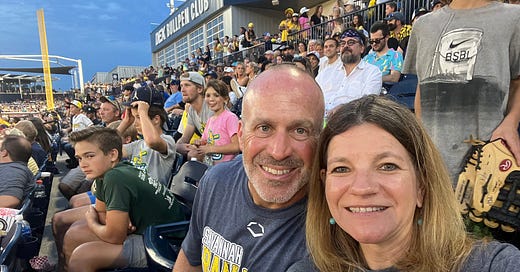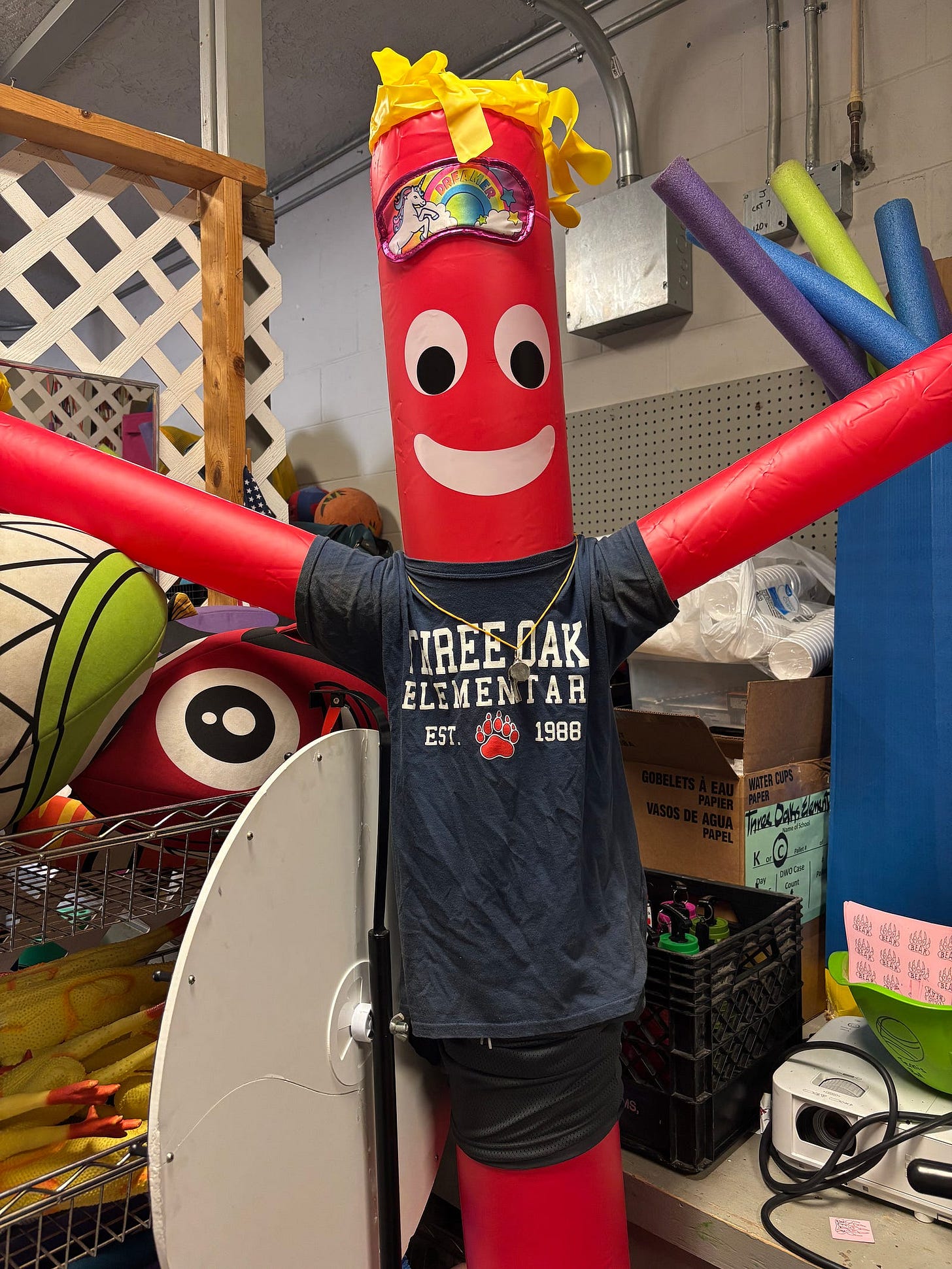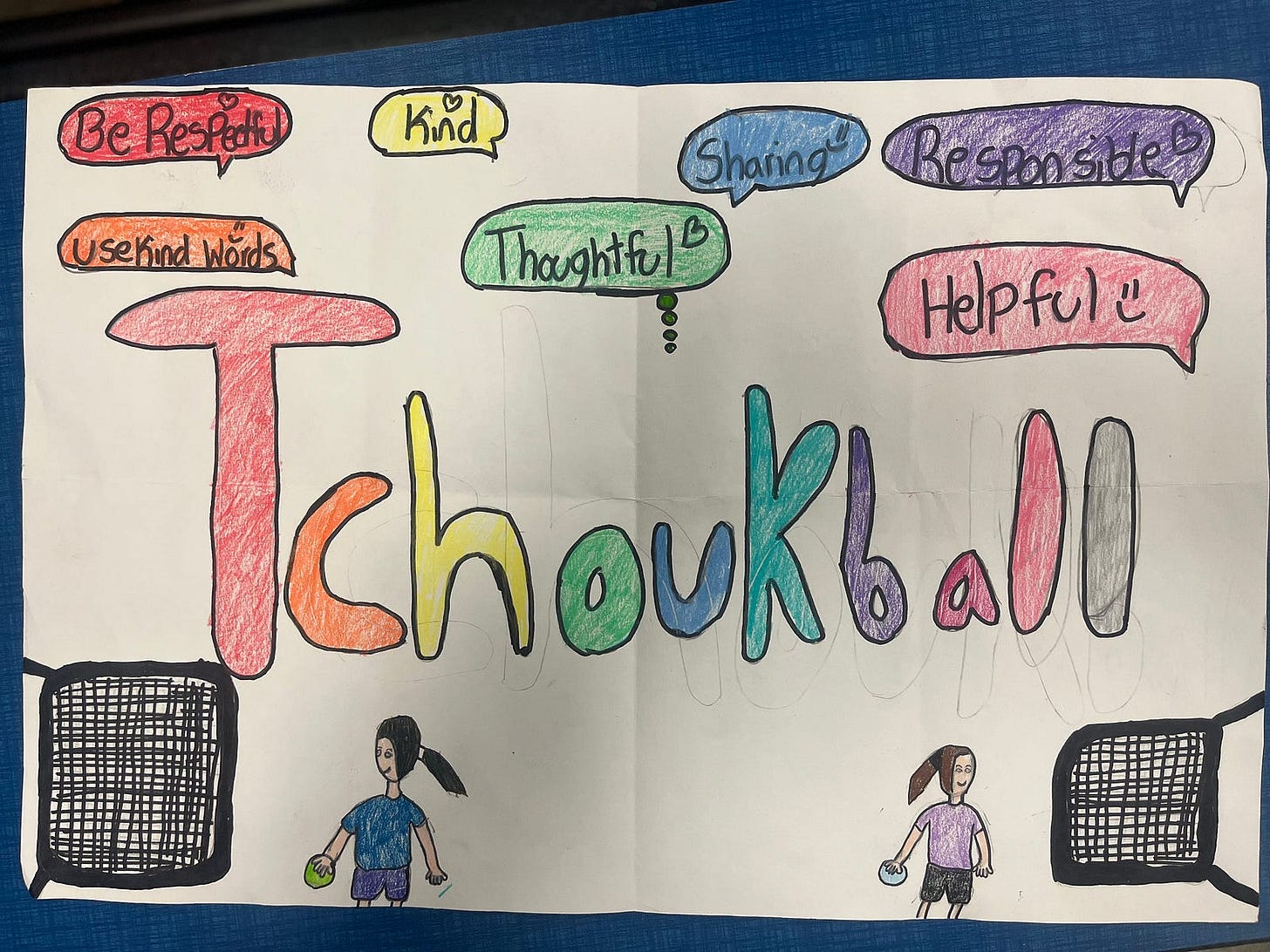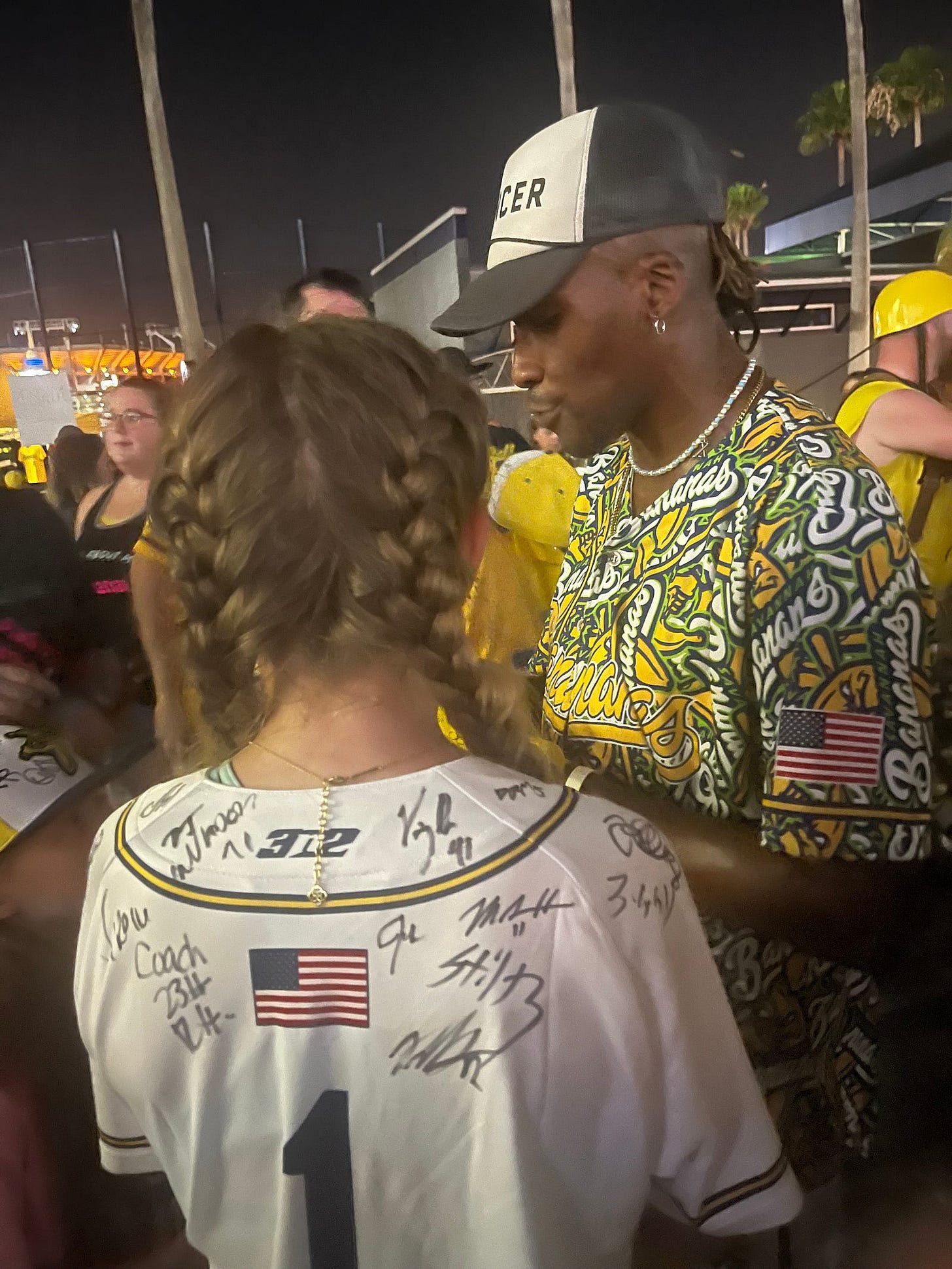I love baseball! As a kid growing up in Buffalo, N.Y. you’d think I was a Yankees fan. However, using the “rabbit ears” (kids-ask your parents!) on the small television in my bedroom, I’d catch Montreal Expos games. The catcher, Gary Carter, aka “The Kid”, was my hero. When he got traded to the Mets I switched my allegiance. The ’86 Mets were my team. I knew every players’ stats and will never forget where I was when Carter started the comeback in game 6 (our living room).
When I moved to Florida in 1994, all those players were gone and I attended my fair share of Tampa Bay Devil Rays (now just the “Rays”) games. They became my team. They still are, although my wife will tell you I’m the worst baseball fan ever. I follow the players for my fantasy baseball team more than care about the standings until the playoffs start. I’ll tell her, “I’d rather the Rays lose this one because they’re going against my starting pitcher. It’s only one game. They play a lot more!”
Now that I have children, I’ve tried to get them into the “Great American Pastime”, but it’s been an uphill battle. My son used to play little league, but got bored at an early age and moved to flag football. My daughter thinks it’s boring, and she’s right. She’s plays flag football, volleyball, and was a competitive gymnast. Baseball can’t keep up.
The game is slow and Major League Baseball (MLB) has tried to adjust in the past decade, but it hasn’t been easy. They’ve added a pitch clock, limited the times a batter can step out of the box and number of times a pitcher can throw over to first for starters, but there’s friction on both sides of the debate.
First, it’s never be fast enough for some people the way a lot of sports are. They want non-stop action. The purists, however, claim it’s ruining the game. They want everything to look like it did in the early 1900’s. It’s just not the same. Me? It took a bit for me to adapt, but I like the faster games. It used to take 2–3 minutes per at-bat because the batters would step out of the box and adjust their gloves after every pitch. Meanwhile, the pitchers would step off the mound walk around to compose themselves. It took way too long. My kids still won’t watch.
Enter the Savannah Bananas. I heard about them a few years ago but didn’t understand what they were all about. Did they play other teams? How could they use different rules? Did they travel?
A brief history
After doing a little YouTube “research” I discovered their funny skits, dance moves and origin. Jesse Cole and his wife, Emily, bought the rights to the team, then renamed it the Savannah Bananas from a “Name That Team” contest. From there, the team played in a summer college league while slowly implementing “Banana Ball” rules. If you’ve never heard of them or are having a difficult time picturing what a game might look like, think of “The Harlem Globetrotters” of baseball. They created a rival team, called “The Party Animals” and began traveling around the country. My wife, kids and I went to see them in Tampa in 2023 and have tickets to see them again in Fort Myers, where we live.
Jesse has several books out, which I’ve either read or listened to. His creativity and vision are impressive to say the least. The Bananas motto is “Fans first. Entertain always.”
Here are five principles they stand for and what I learned from them. These apply to any business or profession. I know they’ve inspired me as a teacher to do more for my students.
#1. Eliminate Friction
We were advised to get to the game a couple of hours early because of the lines and general admission seats. You know those lines: never-ending and never-moving. They’re a “friction point” to the fans, and Jesse and his team have found ways to address this.
First, instead of a line they had everyone go to the front gate where a large crowd gathered. It’s not a long, boring line. As a matter of fact, at the precise time the gate was opening, the Bananas and Party Animals, along with a band came outside to greet us. They were on the top staircase so we could see them. They started with a Mardi Gras beat and moved into “Hey Baby”, complete with choreographed dance moves to entertain us. Jesse then welcomed everyone and opened the gates. The players stayed in the main area to take pictures with the fans. I thanked Jesse for the inspiration and mentioned that I put him in my first book. He was kind and appreciative. My kids went autograph hunting and got pictures with both teams. We even got a selfie with “Stilts”, a player who plays on, well, stilts. Overall, they turned a before-game downtime into an extravaganza!
Teaching Strategy- Find places in your day where you can eliminate friction for your students or yourself. For me, it was the beginning of our PE class, where 4–5 classes would stagger in anywhere from three minutes early to five minutes late. The solution: I start right on time. While my paras are welcoming the teachers and students as they come in, I have them go to their spots and get moving right away. Usually it’s a song or music mix I’ve created, or just a quick rock, paper, scissors game against me. We have 40 minutes and I don’t want to waste any of it. Where is the “friction” point for you?
#2. Entertaining
There was never a dull moment at the game. Baseball has a lot of downtime, but not at a Bananas game. From the moment the gates opened to the fireworks at the end, there was a constant flow of entertainment. After we claimed our seats along the first base line, I went to get food for the four of us. I could hear the crowd cheering, then singing as I waited impatiently. By the time I got back, my kids told me they just finished a baby race, where youngsters crawled to their parents on the infield grass. Not only that, but between every inning there was something going on to delight the fans. Jesse led his New Orleans-style band through the crowd above us and threw out beads after one inning. My daughter found herself in the background of a TikTok video of one of the players singing “Baby” by Justin Bieber! There was a family race where two guys had to go around the bases and pick up one of their kids on first and second base, then their wife on third. Both dads were exhausted coming towards home plate balancing three people on them.
The festivities continued throughout the game. There’s a two hour time limit, which is amazing if you have youngsters. We all sang “Yellow” by Coldplay, as the tradition for their banana-colored theme. There were line dances by both teams and wacky displays of talent everywhere. A player balanced items on his chin, with the finale being a fold-up table, the second baseman jumped off of a barrel to make a catch, and a Party Animal came to the plate with his bat on fire!
Teaching Strategy- While we’re in the educational field to instruct our students, does it have to be rigid in our practice? Can we inject fun and creativity into our teaching? You bet! I’ve done a lot to bring the fun to my students. From a zany mascot, to silly dances, as well as out of the box games and activities (blindfolds anyone?), I’m all about the fun. Stand on your desk like Robin Williams. Ignite passion like Mr. Holland. Teach, inspire, but entertain always like the Bananas.
#3. Experimenting
I should have taken a video of little the girl leading the warmups for the crowd. Jesse had her stand near the pitchers mound and told her we would do whatever she did. It was “Simon Says” with a three-year old. She waved, jumped, stretched and had us all laughing.
How about the 77-year old throwing an inning for the Bananas? Bill Lee, the oldest person to ever pitch in a game came out to the roar of the crowd. While he didn’t light up the radar gun, who cared?
The tallest player ever? Stilts, of course. He got a base hit and ran to first.
This is what they do. They experiment. They also reward their staff for coming up with ideas that succeed or fail. That’s what it’s all about. If you’re not pushing the envelope, you’re not stretching your limits.
Teaching Strategy- Keep pushing. Keep innovating. Try new things. Fail and learn. The “FAIL” acronym:
F= First (or Frequent)
A= Attempts
I= In
L= Learning
My daughter exemplified this when she was younger- VIDEO
When I asked my principal if I could turn our cafeteria into a sporting arena for an hour for the final game in our 5th grade tournament, I thought the answer would be “no”. It wasn’t. In fact, it turned out to be one of my favorite moments in my entire career. The students created an epic game, complete with an announcer, DJs, a halftime show and the National Anthem. Was it perfect? No, but it was incredible and I’ve been doing it every year since then. The 5th graders look forward to it and we’ve created memories for a lifetime.
#4. Engaging
I never saw a player or staff member say “no” to anyone, let alone a child before, during or after the game. Kids were crowding the side of the dugouts for autographs at all times. While they had to wait sometimes, they were never denied. If spectators were late to the opening ceremonies, no problem. Both teams stuck around after the game in the front area for pictures, to chat, and to get those signatures. Plus, we danced with them! Both my children left with their shirts and hats full of ink. What child wouldn’t want to meet their heroes? That’s the power of engagement. That’s the Bananas way. Engage with people. Make connections. Jesse made me feel like we were friends. Sure, I spoke to him for maybe 30 seconds. It didn’t matter. That’s why I’m writing about him now.
Teaching Strategy- Make engaging with your students a top priority. There’s close to 1,000 students in my school. Can I speak to each one in a personable, meaningful way on a daily basis? No, but I can say “hi” to all of them. I can give them a high five, fist bump or hug. I can learn their names. This isn’t as easy as it was when I taught in the classroom. I study the previous yearbook for help. I ask children their names until I remember them (some of them get irritated with my memory, but I try my best). I play “name games” to help me and each other. I know one PE teacher who does push-ups if he forgets a child’s name!
It’s not just their names, however. I make a point to ask questions about their sports outside of school, and even attend some of their events. When we have free days, I’ll play hockey or basketball with my students. I enjoy it and the kids appreciate my efforts. This also helps when there is a conflict or another problem arises. They will trust you more if they feel like they know you. Make connections. Get to know your students.
#5. Empowering
The Bananas make you feel like you are in the game. You’re not just a spectator. You have some control. For instance, one of the “Banana Ball” rules is that if a fan catches a foul ball, the batter is out. I’ve heard that this can be very strategic, because the Bananas are the “good guys”, while the Party Animals are the “bad guys”.
Once, a fan got booed because he caught a Bananas foul ball. The batter was out and it cost them a run. I’ve heard fans who purposely drop foul balls because of this, while catching a Party Animals ball is ground for celebration! In fact, Jesse brings the fan down to the mound so everyone can cheer for them.
Another one is called the “Banana Ball Challenge Rule”, where any fan can challenge a call on the field. I’m excited to see this in action soon, as it’s a newer rule since I attended.
Teaching Strategy- How can you empower your students? I choose 4th and 5th grade safety patrol (SP) to help our little ones get to class and make sure kids are walking around campus in an orderly manner. I have a captain I choose each year to help me find posts for the SP and float around if I’m unavailable.
I also choose 3rd, 4th and 5th graders to lead field day stations. They teach the parent volunteers, as well as the teachers and classes that come to them. These are both high honors to my students.
I pick student leaders to help referee games, set up and clean up equipment, and even go to the office for bandaids or walk someone to the clinic. I’ve given my keys to a student (my SP captain) to go to the media center for me because I left my water bottle there. I probably shouldn’t have done that, but I knew I could trust her.
Could I clean up the equipment, walk to the office and go back for my water bottle? Sure. It may seem like I was being lazy, but I enjoy giving tasks to the children if they want them. Kids beg to help clean up! I want to help them gain trust and responsibility. Sometimes I think of the pastor (John Lithgow) in Footloose telling his congregation, “If we don’t start trusting our children, how will they ever become ‘trustworthy’?”
What about the “troublemakers”? Sometimes it helps to give them a job. Make them a captain. Have them be your helper for the day. I used to think this was rewarding poor behavior, but if you’re strategic about this, that student could become your biggest ally.
Give options, jobs and responsibilities to your students. Let them feel a sense of empowerment. You’ll be amazed at the results.
Conclusion
If you get a chance, go to a Savannah Bananas game or check them out online. I went with a teacher’s eye and took a lot of notes on my phone (I still had fun, don’t worry!). They taught me how I should engage with my students and create new and exciting experiences. They connected with their fans and made memories for my family. It’s been a year and a half since that game and I’m still talking about them. The only problem: My kids won’t go to any regular baseball games anymore. It’s Bananas or bust from now on!
Link to my podcast on the Savannah Bananas
Follow me on Substack for more articles and links to my podcast.










